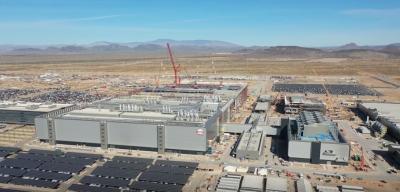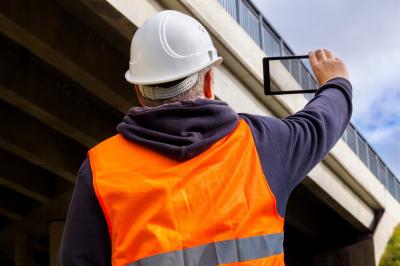Just a few years ago, J. Turner Butler Boulevard (State Road 202) on Jacksonville’s Southside was a limited-access, four lane expressway providing another east-west alternative that locals dubbed “the road to nowhere.”
Today, the residential, commercial and retail boom on the Southside, at the beaches and in St. Johns County, which was spurred partly by the road’s presence, has transformed the expressway into “one of the most heavily traveled corridors in the entire city,” according to Florida Department of Transportation (FDOT) spokesperson Mike Goldman.
In 2001, the two-way vehicle count on Butler Boulevard east of Kernan Boulevard was 59,000. By 2005, the number jumped to 83,500. In 2006, the number escalated to 93,000, leading to massive traffic congestion and several road improvement plans, including a $26.5 million widening project covering 5.8 mi. (9.3 km) of Butler Boulevard from east of Kernan Boulevard to San Pablo Road.
“It’s one of the highest growth corridors in the entire Northeast Florida area,” Goldman said. “The pavement has been worn and it needs additional capacity. That’s why the job is being done.”
The project includes widening Butler Boulevard from four to six lanes, drainage improvements, pavement repair and resurfacing. Jacksonville-based J.B. Coxwell Contracting Co. is the prime contractor for the project, which started July 9 and is scheduled for completion in early 2010. Coxwell was the low bidder for the job.
Founded in 1983 by J.B. Coxwell, the company initially specialized in clearing and earthwork. It later expanded to include site development, underground utilities and public and private highway and civil construction. The company has built an outstanding reputation in northeast Florida and has never filed a lawsuit, or had a lawsuit filed against it by owners, designers or engineers during its history.
“They’re a local company that’s done a lot of work for the city and jobs for us,” Goldman said. “They’re a good contractor.”
Butler Boulevard or JTB as the locals call it, opened in 1979 and runs approximately 13 mi. (21 km) from U.S. 1 in Jacksonville to SR A1A in Jacksonville Beach just north of Ponte Vedra Beach in St. Johns County. Named for James Turner Butler, a well-known Jacksonville attorney and Florida legislator who was instrumental in several transportation projects in northeast Florida, Butler Boulevard was a toll road until 1988.
Because of heavy traffic and projected growth, FDOT conducted a study in 2000 on making long-term improvements to Butler Boulevard, including widening the road.
In early 2004, the first phase of the widening project started between Gate Parkway and Belfort Road on the west end of Butler Boulevard.
In May 2005, FDOT awarded a $81.2 million contract to Superior Construction Company to reconstruct the SR 9A/Butler Boulevard interchange, which includes circular ramps, some up to 60 ft. (18.3 m) in height. The existing bridges and median on Butler Boulevard will be widened to accommodate four westbound travel lanes and three eastbound travel lanes.
Last year, the state opened a new portion of SR 9A that extended the roadway past the University of North Florida almost to the intersection with Butler Boulevard. The less-than-half a mile (0.8 km) stretch of St. Johns Bluff that now remains will be turned into a retention pond once the interchange is finished, which will allow SR 9A to flow openly to its connection with Interstate 295.
The interchange project is being done simultaneously with the road widening project, creating some additional challenges for both jobs.
“There is another project about a mile or so at St. Johns Bluff Road, the big interchange reconstruction project,” Goldman said. “That required some careful coordination between two different contractors for traffic management sequencing, that sort of thing. With two projects, two contractors, two sets of consultants, there has been some coordination issues.”
Goldman said by and large the traffic management plan has worked well, limiting the impact on commuters.
“It’s been going pretty well,” Goldman said. “We do have to tweak it occasionally. One detour on one project runs into a detour on the other project so work schedules must be coordinated.”
While coordinating two separate projects offers one challenge, Mike Tippit, field project administrator of PB (formerly Parsons Brinckerhoff), said traffic tops his challenge list.
“Traffic is the main one,” Tippit said. “And coordinating with the adjacent project I would say in the next biggest thing. We have a lot of meetings. Keeping the public informed about lane closures is a big thing. We’ll have a couple of traffic shifts as the phases progress, primarily at night so the traffic is lighter. We try to keep it to a minimum.”
Eastbound lane closures are allowed from 7 p.m. to 7 a.m. (one lane) and from 8 p.m. to 6 a.m. (two lanes). Westbound land closings are allowed from 8 p.m. to 6 a.m. (one lane) and from 7 p.m. to 5:30 a.m. (two lanes).
“The biggest challenge is the volume of traffic and the fact that work has to be done at night,” Goldman said. “We’re going to be doing some ramp closings. The job is fairly routine as far as construction, but the fact of where it is located, a main corridor to the beach, the location is probably the biggest challenge.”
Though in its early phase, the project is running slightly ahead of schedule.
“Right now we’re pretty much on schedule, but it’s still early,” Goldman said. “Actually, we’re a little ahead of schedule, about 6 percent complete. Coxwell is very good about time management.”
Currently, crews are building an embankment in the center median.
“The prime contractor is presently working on bringing the embankment to the center median to build it up to what will be the inside lanes, east and west,” Tippit said. “That’s where the majority of the widening is taking place.”
Tippit said once that work is complete a concrete barrier will be installed to separate traffic. Once that’s finished crews will work to the outside to widen the shoulders about two feet.
“The subcontractor, Hal Jones Contracting, is working on the bridges,” Tippit said. “Hal Jones is working on doing the test pilings. They’re using cranes and pile hammers.”
Besides Hal Jones Contracting, there’s a host of subcontractors, including Ameriseal Highway Striping, pavement markings; Belcorp Inc., fencing; Blount-Stanford Construction, barrier wall; Duval Asphalt Products, milling and asphalt work; Erosion Stoppers Inc., erosion control items; FL Pipe Tec Inc. desilting and videoing; Miller Electric Company, electrical work; RLH Enterprises Inc. dba North Florida Landscaping, landscaping; Safety Contractors Inc., guardrail and signs; Standard Specialties, culverts and headwall; Thomas Grinding, rumble strips; Trujillo Construction, jack and bore operations; Acme Barricades, traffic management; JE Hill Contractor Inc., setting up the barrier wall, and Concrete Cutting and Breaking, demolition of bridge deck.
There’s also a full range of equipment on-site.
“Coxwell has the basic earthwork equipment,” Tippit said. “Some drainage is going in so they have some trackhoes, front end loaders, dump trucks. They’re moving earth and digging ponds.”
Tippit said there are about 50 workers on-site, including subs. During the day they’re doing the bridge and drainage work.
“Anything pertaining to actual road work, the median, milling, resurfacing, is done at night,” Tippit said.
Looking ahead to the next phase, Tippit said after the grading is complete they’ll bring in the lime rock base and begin paving the inside lane. According to the FDOT, 47,241 tons (42,856 t) of asphalt is being used on the job.
“The next phase will then shift traffic to the inside so they can work on the outside, existing lanes and resurface that,” said Tippit, adding they haven’t had any unusual circumstances to delay the project. “Not on this job. It’s happened to me in the past, but not on this one.”
When the project wraps in the 2010, the improvements should ease traffic congestion on Butler Boulevard and make it a whole lot easier to get around Jacksonville. Butler Boulevard will now intersect two interstate highways, I-95 and the I-295 loop around Jacksonville. Completion of the loop will help to increase accessibility throughout Jacksonville and should ultimately decrease congestion on I-95 and in the downtown Jacksonville area, according to the FDOT.
Quite a change from its humble beginnings as “the road to nowhere.” CEG
Today's top stories















